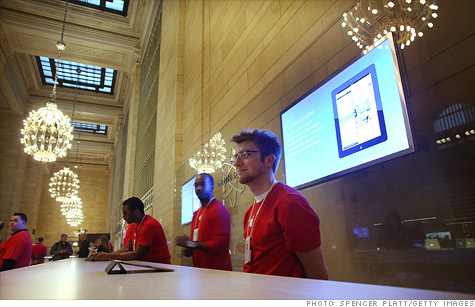Search News

Employees at the new Apple store in Grand Center Terminal in New York. Most Apple employees work in the company's retail division.
NEW YORK (CNNMoney) -- There's no doubt that Apple is doing far better than the U.S. economy as a whole. But that doesn't mean Steve Jobs had a better jobs record than Barack Obama.
Last night in the Republican's response to the president's State of the Union address, Indiana Gov. Mitch Daniels proclaimed that Apple has created more jobs than President Obama's job creation program did.
"The late Steve Jobs -- what a fitting name he had -- created more of them than all those stimulus dollars the President borrowed and blew," Daniels said.
The only problem with that nice play on the Apple founder's name is that Daniels' math just doesn't add up, no matter how successful and valuable Apple (AAPL, Fortune 500) has become.
Not even close.
Apple's latest filing shows the company had about 60,400 full-time employees and 2,900 temporary and contract workers. About two-thirds of those jobs are in the United States.
And most of those Apple employees are not high-paid engineering or manufacturing jobs -- 36,000 are in company's retail division. (An Apple store is worth as much as the White House)
Jobs also founded animation studio Pixar, which he sold to Disney (DIS, Fortune 500) in 2006. It had 850 employees at the end of its last year as an independent company. So even if it has doubled employment since then, it wouldn't add much to the total who worked directly for Jobs.
Of course there are lots of other workers at Apple suppliers who actually assemble the iPhones, iPads and other products. The New York Times recently reported that there are 700,000 of those workers at other companies, a number Apple would not comment upon.
The overwhelming majority of these jobs are outside the United States, such as the giant Foxconn plant in Shenzhen, China.
There are some U.S. plants that produce parts for Apple. Glassmaker Corning (GLW, Fortune 500) employs about 1,000 people at its U.S. plants making its product, known as Gorilla Glass, for Apple products. Reuters reported in December that an Austin, Texas, Samsung plant recently added 1,100 jobs primarily to supply Apple with chips for the iPhone and iPad.
What's tougher to calculate is jobs created by those outsiders programming for Apple products.
For example, technology job site indeed.com has almost 5,000 job openings for people who create iPhone and iPad app's. But it's not clear if Steve Jobs deserves credit for those jobs.
But estimates of jobs created by the $787 billion 2009 stimulus act show that Obama's stimulus program helped many more people become gainfully employed than did Apple.
The nonpartisan Congressional Budget Office estimates that the stimulus act passed in February 2009 saved or created at least 1.4 million jobs.
And a separate study by Mark Zandi, chief economist of Moody's Analytics and an advisor to John McCain's presidential campaign, and Alan Blinder, a former Federal Reserve vice chairman and advisor to President Clinton, estimates that the stimulus act created about 2.7 million jobs.
While it wasn't part of the stimulus act, the Obama administration also saved and created significantly more jobs through its bailout of the U.S. auto industry.
According to a study by the Center for Automotive Research (CAR) a Michigan think tank, the bailouts of General Motors (GM, Fortune 500) and Chrysler Group saved 1.5 million jobs.
And more jobs are likely in the pipeline thanks to hiring plans announced by GM, Chrysler and Ford Motor (F, Fortune 500). CAR estimates that the auto industry will likely add almost 170,000 jobs nationwide by 2014 creating a jobs boom in the auto states of Michigan, Ohio and Gov. Daniels' home state of Indiana.
Still, Daniels' staff is defending his math.
"Between Apple and its suppliers, there are hundreds of thousands of jobs that have been created and sustained over years and years," said his press spokeswoman Jane Jankowski. "Meanwhile, a number of credible economists, including Robert Barro of Harvard have questioned whether the stimulus created any net new jobs; if they did, the jobs were temporary and disappeared as the stimulus money ended." ![]()